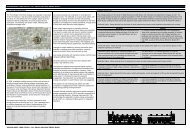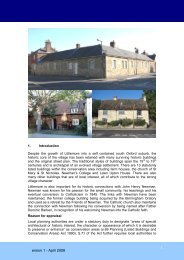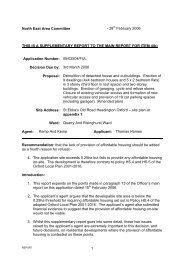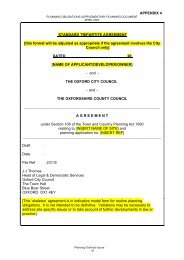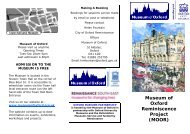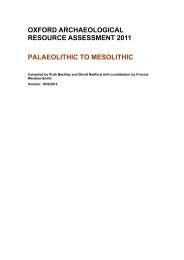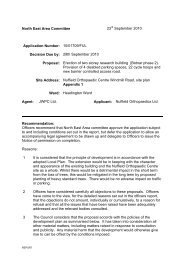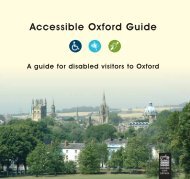Post-medieval Oxford - Oxford City Council
Post-medieval Oxford - Oxford City Council
Post-medieval Oxford - Oxford City Council
Create successful ePaper yourself
Turn your PDF publications into a flip-book with our unique Google optimized e-Paper software.
Site Description Source<br />
The Lion Brewery (UAD 416) Excavated floor surface Moore 2006<br />
22 St Michael’s Street (UAD 1280) Excavated floor surface UAD 1280<br />
9 Ship Street (UAD 1281) Excavated floor surface, undated UAD<br />
19 Holywell Street (UAD 1442) Excavated in 19th century Hurst,1887<br />
Beef Lane (UAD 1443) Recorded observation Hurst,1887<br />
The Hamel (UAD 1444) Recorded observation Hurst 1887<br />
Holybush Row (UAD 1445) Sack for bone floor Hurst 1887<br />
Logic Lane (UAD 1446) Recorded observation Hurst 1887<br />
Ashmolean Museum (UAD 1447) 17th century bone floor Hurst 1887<br />
59 George Street (UAD 1454) Recorded observation Hurst 1887<br />
Black Swan, George Street (UAD 1455) Recorded observation Hurst 1887<br />
Littlegate Street Ongoing excavation <strong>Oxford</strong><br />
Archaeology<br />
forthcoming<br />
Table 3: Location of bone floors in <strong>Oxford</strong><br />
Former monastic precinct – Greyfriars<br />
The St Ebbe’s redevelopment also offered an opportunity to investigate the impact of<br />
the Dissolution on the precinct of the Greyfriars. By 1544, the Greyfriars had largely<br />
been demolished, although parts of the choir and nave remained as property<br />
divisions until the building of the Westgate Centre. <strong>Post</strong>-Dissolution, the site was<br />
subject to property speculation, eventually leading to sub-division and the laying out<br />
of the street frontages. The excavation largely investigated areas to the rear of the<br />
later frontages and therefore largely encountered rubbish pitting. One 17th century pit<br />
near to the north choir wall contained luxury glass beakers, another pit contained<br />
butchery waste, (Hassall and Halpin et al. 1984: 173). An 18th century pit contained<br />
the bones of domestic fowl and spur cut-offs, thought to be related to the use of<br />
metal spurs to prepare cocks for fighting. Another notable pit assemblage of late 18th<br />
century date contained Chinese porcelain tea and coffee wares, and exotic<br />
glassware. The former orchard of the Greyfriars, known as ‘Paradise’ contained 18th<br />
century pits that produced notable pottery and glass assemblages. Another 18th<br />
century pit produced a horn-core lining, no doubt linked to the known nearby<br />
tanneries; the same pit produced a piece of glass chemistry apparatus (ibid.: 174).<br />
The investigations noted that by the 17th century, the market space outside the<br />
castle barbican had seen significant encroachment following its closure in 1578.<br />
Deposits associated with the demolition or robbing of structural elements of the<br />
Greyfriars were present in numerous evaluation trenches excavated at the Westgate<br />
Car Park in 2006 and 2008. The evaluation also recorded the post-<strong>medieval</strong> fills of<br />
the Trill Mill channel cut by the construction cuts for the 18th century canal<br />
constructed along the channel, (Bashford 2008).<br />
Former monastic precinct – Rewley Abbey<br />
Extensive trial trenching within the precinct of the Rewley Abbey between 1986 and<br />
1994 produced remarkably little evidence for post-<strong>medieval</strong> activity. The site<br />
remained occupied until the 19th century; a sequence of mortared floors from the<br />
retained north range and domestic waste including a small assemblage of glass<br />
bottles were recovered. Much of the grounds of the former abbey were converted to<br />
a formal garden and possible ponds; a stone lined irrigation drain and garden soils<br />
were noted (Munby et al. 2007: 29-31).<br />
OXFORD ARCHAEOLOGICAL RESOURCE ASSESSMENT- POST MEDIEVAL<br />
20



